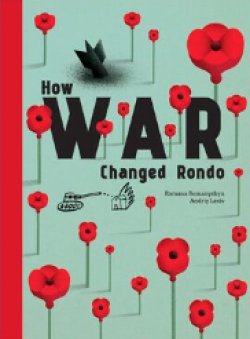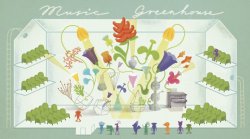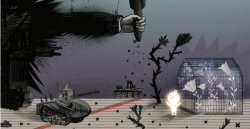Maughn Rollins Gregory

How War Changed Rondo by Romana Romanyshyn and Andriy Lesiv; translated from Ukrainian by Oksana Lushchevska. New York: Enchanted Lion Books, 2021.
The War That Changed Rondo [Animated film, produced with support from the Ukrainian Cultural Foundation], directed by Olha Havrylova. Kyiv, Ukraine: Chervoniy Sobaka [Red Dog], 2020. URL = https://vimeo.com/391490389.
Every town has a geography of childhood—a landscape of spaces where children think, play, brood, and invent. The town where I grew up had playground corners, fruit orchards, church basements, and crawl spaces under bushes and behind fences where friends and I explored the given world and invented our own. Both activities were necessary for me to make sense of my town and my life in it. Of course, the geography of childhood is not a paradise. There is risk and rule-breaking, crudeness and cruelty. And there is the intrusion, sometimes violent, of adults into that landscape.
The town of Rondo, imagined into existence by Ukrainian artist-authors Romana Romanyshyn and Andriy Lesiv, is made from only the sunny stuff of childhood. As the story begins, it is described as a town “like no other”:
[blockquote]There, the air was uncommonly clear, as if spun from pure light. The town’s residents […] grew flowers, tended the parks and gardens, and built distinctive houses. They also spoke to birds and plants, painted pictures, sang, and wrote poetry. Everyone liked living in Rondo.[/blockquote]
As portrayed in the first pages of the book and the first minutes of the animated film, Rondo is a place of beauty, joy, and integrity. The residents are fantastical, gender- and age-ambiguous creatures of many colors. The three protagonists of this story are Danko, a lightbulb with a “thin, transparent body that glowed like a lantern,” Fabian, a fuchsia balloon dog with “a good nose and sharp eyes,” and Zirka (‘Star’ in Ukrainian), an origami bird who can fly “and even perform complex aerobatics.”
Music is central to the idyll of Rondo. Its name is derived from Mozart’s Rondo alla Turca, the town’s anthem, and its cultural apex is a “Music Greenhouse” located in the main square, where townspeople tend “a collection of rare flowers and plants from the farthest corners of the earth”—all of which can sing. “[T]he chorus of flowers […] sang every morning at dawn,” and “There were frequent concerts in the greenhouse.” The film shows Rondo residents waking up and standing at their windows to listen and add their voices to the ethereal music (composed by Nikita Moiseev).

Suddenly, pages 11-12 of the book are dark gray, showing a line of military tanks on the move, leaving behind towering thorn bushes and followed by a black whirlwind. The text reads: “WAR is coming to Rondo.”
[blockquote]Nobody knew what War was. It seemed to come from nowhere. It was black and scary. It rumbled and roared. It crept slowly toward Rondo, bringing destruction, turmoil, and dense darkness. Everything it touched disappeared into nothingness. Most frightening of all were the black flowers and the dry, spiked weeds War planted in its wake. Mute and scentless, these flowers erupted from the earth, forming dense thickets that blotted out the sun. Without the light, the delicate and defenseless flowers of Rondo started to weaken and fade […].[/blockquote]
This is a picture book and film in which the artwork is as meaningful and provocative as the text (indeed, there are no words in the film). War is depicted as a gigantic, shape-shifting amalgamation of buildings, war machines, and a mechanical human arm (replaced in the film with furry and scaly arms with sharp claws and mechanical arms with pincers), from which emerge tanks with eyes and jagged mouths, mosquito-like helicopters, and other “terrible clinking and hissing machines.” In the book, the word ‘War’ is a proper name, referring not to an event but to a malevolent being. But this War is more machine than animal (though its machines wear faces). It is polymorphous, mutating, and multiple, birthing an army of air and land machines that “hurled sharp stones and spit fire.” Nor does War seem to have any goal or intention other than indiscriminate destruction.

These images raise a number of important questions about the nature of large- and small-scale violence (such as, in my country, political insurrection, police violence, and mass shootings). Who is the agent of (this or that) war? Who-all is responsible? If war requires the participation of many people, how does that happen? Have you ever been part of a team, family, or group of friends that made you think, feel, say, or do things you would not have done on your own? How can we tell when that’s a good thing or a bad thing? Do the technologies we use become part of who we are? Do our technologies ever use us, instead of us using them? Should we make laws against making and using certain kinds of weapons?
There’s no way to think about war without considering the possibility of just war, including defensive war and revolution against imperialist occupation. In Rondo, the three friends ask War to go away, but then speak to War “in its own language,” by hurling stones and nails at it. Each is wounded in the failed attempt. Is violence against the violent justifiable—on the playground or between countries? Is pacifism honorable? Does it depend on who is waging violence against whom, for what reasons?
One day Danko tries to revive the surviving flowers in the Musical Greenhouse by peddling his bicycle to power up its lamp and shine it on them. The light begins to revive the flowers and when Danko loses his grip on the handlebars, the bike lamp turns to shine on War, which is immobilized for an instant. The book explains the metaphor as a platitude: “the truth is that even the smallest ray of light will begin to disperse the darkness.” Realizing this, the remaining citizens of Rondo come together to build a “light machine” composed of “Hundreds of pedals and thousands of gears” that generate numerous lamps turned on War, which “started to dissolve in the light,” until “the darkness had dissolved completely. VICTORY!”
How War Changed Rondo was created in 2014 in response to Russia’s annexation of Crimea and occupation of the eastern part of Ukraine. It won the prestigious Bologna Ragazzi Award in 2015 and, in its English translation, was recognized as a Kirkus Best Book of 2021 and a USBBY Outstanding International Book of 2022. The book’s English translator, Oksana Lushchevska, has explained that,
[blockquote]While many of my Ukrainian colleagues are hiding in bomb shelters, they seek children’s books to soothe their children through the difficulties and hardship. Ukrainian publishers have distributed free digital copies of contemporary Ukrainian children’s books, some of which are books about peace and war. In this way, children can choose what they want to read and talk about. Some of them ask to read about peace to strengthen their hope. Others ask to read about war to have the possibility for catharsis. (Lushchevska, 2022)[/bloackquote]
Clearly, one of the purposes of the book and film is to provide hope to children experiencing war and displacement, in Ukraine and elsewhere. Philosophically, however, every story’s moral is an opportunity for wonder. How true is it that the smallest light can eventually disperse an overwhelming darkness? Is struggle against injustice warranted when it is likely to fail?
One of the philosophically significant aspects of the book and the film is the meanings they give to color. The inhabitants, buildings, and plants of pre-war Rondo are diversely and vividly colored. In dramatic contrast, War is both described and illustrated as “black and scary.” It changes every landscape to a grayscape, where black thorn bushes proliferate. Smoke can be black and gray and it can block sunlight, but the darkness of this book is overtly metaphorical, which obliges a meta-textual discussion with children about the cultural connotations of color. While it is common for children (and adults) to be afraid of the dark, darkness and dark colors in the natural world are often valuable and beautiful. To equate darkness and dark colors with fear, sadness, inferiority, and immorality (dark mood, black humor)—has consequences for how we un/consciously think of human skin color. Young children are savvy enough to think carefully about value judgments they and we sometimes make about light and darkness, light colors and dark colors.
Red is the predominant color in the end of the story of Rondo: the red of poppies that “began to spring up where the black flowers had been.” A footnote informs readers that in World War I, the red poppy became the international symbol of remembrance of those who lose their lives in war. As they rebuild their town, the citizens of Rondo realize that War has changed it forever. Everyone has been scarred and everyone has sorrowful memories. As the footnote suggests, keeping the memory of an atrocity alive is often urged as a moral imperative, both to honor the victims and the heroes who fought against it, and to be on the lookout for signs of a recurrence. This too, is a doorway to philosophical questioning. What kinds of moral and political lessons can we learn from history and memory? Can history and memory play a part in present wrongs? Is it possible or desirable to forgive a wrongdoer while actively maintaining the memory of the wrongdoing?
Though not intentionally, perhaps, How War Changed Rondo presents opportunities for intergenerational philosophical inquiry into questions about violence and war that, tragically, are all too timely.
Reference
Lushchevska, Oksana (2022) Reading “How War Changed Rondo” to Open Conversations about the War in Ukraine. The Children’s Literature Assembly Blog, 3/8/2022. URL = https://www.childrensliteratureassembly.org/blog/reading-how-war-changed-rondo-to-open-conversations-about-the-war-in-ukraine.
